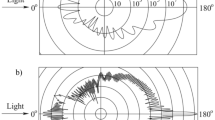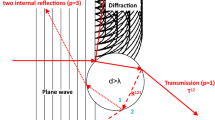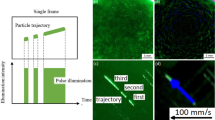Absract
In the development process of electrophotography, charged dielectric toner particles move in a micro-gap between the photoreceptor and the development roller to form images by the action of electrostatic force. To improve image quality, it is important to clarify the toner particle motion and the effects of the electric field on this motion. In the present study, Particle Image Velocimetry (PIV) was applied to measure the toner particle motion and the results were compared to calculated results. It was confirmed that the toner velocity increased with increasing electric field intensity, and that the measurement results agreed with the calculated results. These results indicated the usefulness of PIV in analyzing toner particle motion in the development process.
Similar content being viewed by others
References
Cundall, P. A., Strack, O. D. L., A Discrete Numerical Model for Granular Assemblies, Géotechnique, 29-1(1979), 47–65.
Hirabayashi, J., Measurements and Analyses of Toner Motion in the Development Process, International Congress of Imaging Science, (2002), 565–566.
Hirooka, N., Oba, S., Nakayama, N., Kawahashi, M. and Watanabe, M., Motion Analysis of Toner Particles in a Micro-gap in Development Process of Electrophotography, Journal of the Visualization Society of Japan, 21-1(2001), 263–266.
Howard, M., Jim, B. and Palghat, R., Optical Measurements of Toner Motion in a Development Nip, Journal of Imaging Science and Technology, 44-3(2000), 210–218.
Ito, T., Kawamoto, H., Okamoto, H. and Hidaka, J., Numerical Analysis for Behavior of Developer in Magnetic Brush System by the Particles Method, The 12th Symposium on Electromagnetics and Dynamics, (2000), 589–592.
Kaga, A., Inoue, Y. and Yamaguchi, K., Pattern Tracking Algorithms for Airflow Measurement Through Digital Image Processing of Visualized Images, Journal of the Visualization Society of Japan, 14-53(1994), 38–45.
Kubota, T., Inoue, H. and Iino, Y., Two-Dimensional Analysis of Background Defect by Large Particles in Magnetic Single Component Development System of Electrophotography, The Society for Imaging Science and Technology’s NIP16: International Conference on Digital Printing Technologies, (2000), 751–755.
Nakano, M., Analysis of Toner Motion in the Development Process, Electrophotography, 36-3(1997), 45–55.
Nakayama, N. and Mukai, H., Numerical Simulation of Compression of a Toner Layer in Electrophotography Process, ASME Special Volume, Advances in Information Storage Systems, 10(1999), 223–236.
Nishino, K., Toward Practical Three-Dimensional Particle Image Velocimetry, Journal of the Visualization Society of Japan, 20-77(2000), 7–13.
Uchida, K., Visualization Analysis of Air-Curtain for Prevention Toner Scattering in a Copier Developer, The 10th International Symposium on Flow Visualization, Kyoto, (2002), 14.
Uemura, T., Yamamoto, F. and Koukawa, M., High Speed Algorithm for Particle Tracking Velocimetry, Journal of the Visualization Society of Japan, 10–38(1990), 58–64.
Author information
Authors and Affiliations
Additional information
Nobuyuki Hirooka: He received his MSc(Eng) degree in Mechanical Engineering from Meiji University (1998). In 1998, he joined Fuji Xerox Co., Ltd., where he has been engaged in research on electrophotography. He is currently working on numerical simulation and measurement of powder dynamics in electrophotography. He is a member of the Japan Society of Mechanical Engineering.
Shota Oba: He received his MSc degree in Applied Physics and Chemistry in 1985 from University of Electro-Communication. In 1995, he joined Fuji Xerox Co., Ltd., where he has been engaged in research on electrophotography. He is currently working on the development of new electrophotography technology.
Nobuyuki Nakayama: He received his BS degree in Physics from Tohoku University (1983). In 1983, he joined Fuji Xerox Co., Ltd., where he has been engaged in research on electrophotography. He is currently working on numerical simulation and the measurement of powder dynamics in electrophotography. He is a member of the Imaging Society of Japan and the Japan Society of Mechanical Engineering.
Masaaki Kawahashi: He received his MSc(Eng) degree in 1968 from University of Electro-Communication, and his D.Eng. in 1978 from the University of Tokyo. After receiving his MSc he worked as a Research Assistant, a Lecturer and an Associate Professor at Saitama University before entering into his current position as a Professor at Saitama University. His research interests include thermo-fluid phenomena by finite amplitude wave motion in ducts, speckle metrology for density field measurements and PIV measurement of complex flow fields in centrifugal fans.
Masafumi Watanabe: He received BSc(Eng) degree in 2001 from Saitama University and is currently earning his MSc at the Graduate School of Science and Engineering, Saitama University.
Rights and permissions
About this article
Cite this article
Hirooka, N., Oba, S., Nakayama, N. et al. PIV measurement of toner particle motion in a micro-gap in the development process of electrophotography. J Vis 6, 175–184 (2003). https://doi.org/10.1007/BF03181622
Received:
Revised:
Issue Date:
DOI: https://doi.org/10.1007/BF03181622




